


M296 .50 Cal. (12.7mm) MACHINE GUN
The XM296 is a pod mounted, automatic, recoil-operated, link-belt fed, air-cooled machine gun. The
weapon has a maximum rate of fire from 750-800 rounds per minute (500-650 rounds per minute
desired). Ammunition is fed from the right side of the machine gun, to facilitate left-side applications on the
OH-58D firing platform. The percussion-type primed ammunition is fired by actuating the gun-firing
solenoid. The XM296 machine gun functions in the same manner as the M2 .50 cal. machine gun, except it
is fired remotely using an electrical solenoid.
The M296 has a maximum firing rate of 750-850 rounds per minute. This firing rate is adjustable, however, the firing rate of the gun is normally adjusted to approximately 500 rounds per minute. At 500 rounds per minute rate, a 6 second continuous burst will fire approximately 50 rounds which falls within the burst restriction guidelines.
- Combat firing is unrestricted but bursts of longer than 150 rounds may lead to gun stoppage due to overheating of the gun barrel.
- Noncombat bursts of automatic fire are limited to an effective sustained firing rate of 50 rounds per minute. Meaning the M296 can fire 50 rounds per minute every minute until the ammunition can is emptied.
- A noncombat single or combined maximum burst of 150 rounds may be fired. After firing such an overheating burst, the barrel must be allowed 10-minutes to cool.
A 50 round per minute burst restriction is required because the M296 machine gun is air-cooled. Because of the absence of cooling medium, the temperature of the barrel rises rapidly during firing. The longer the burst, the higher the temperature attained.
The progressive heating of the barrel gives rise to several effects some of which are as follows:
- Accelerated wear of the bore.
- Expansion of the barrel leading to loss in bullet velocity and finally to tumbling of the
projectile.
- Stoppage of gun caused by the expanded barrel seizing in the trunnion block or flash
suppressor.
- . Ignition (cook-off) of the propelling charge by the heat of the barrel.
A 50 round per minute burst restriction allows the gun to fire a maximum of one 50-round burst or a maximum of five 10-round bursts in a given 60 second period. Any combination of bursts is permissible as long as only 50 rounds are fired in a 60 second period. Example: At time zero, a 10 round burst is fired. Ten seconds later a 24 round burst is fired.
Ten second after that a 15 round burst is fired. Essentially, a total of 50 rounds have been fired in approximately 20 seconds. The gun has reached its 50 round threshold and should therefore be allowed to cool for 40 seconds prior to firing the next set of bursts.
If an overheating burst is fired, the gun should be cleared within 10-seconds after completion of the burst. IF the gun cannot be cleared within 10 seconds, the round should be allowed to remain in the chamber a minimum of 5 minutes, making sure the gun is aimed in the opposite direction from personnel and equipment. If an attempt is made to
clear the gun between the 10 second and the 5 minute period, the extracted cartridge may explode outside the weapon causing serious injury to personnel or equipment.
The ginbal ring serves as the mechanical interface between the machine gun trunnion and the gun cradle. It provides 2-axis movement for machine gun boresight adjustments.
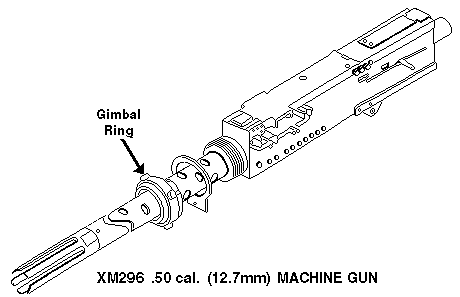 The bolt group is the major recoiling assembly in the weapon. During the firing of the weapon, the bolt group cocks the firing pin, extracts the cartridge case, actuates the belt feed lever to advance the ammunition belt, and chambers a new round of ammunition. The bolt is mounted within the center of the receiver.
The bolt group is the major recoiling assembly in the weapon. During the firing of the weapon, the bolt group cocks the firing pin, extracts the cartridge case, actuates the belt feed lever to advance the ammunition belt, and chambers a new round of ammunition. The bolt is mounted within the center of the receiver.
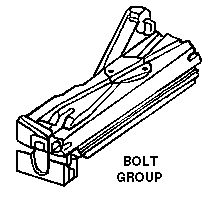 The barrel buffer group, housed in the buffer body, is composed of the buffer body assembly and the buffer assembly. During weapon operation the barrel buffer accomplishes the following functions: brings the barrel and barrel extension to rest (cushioning the shock, and holding them on recoil), transmits barrel and barrel extension recoil energy (through the accelerator, to speed-up the recoil of the bolt), returning the barrel and barrel extension to battery (by means of the buffer spring expanding assisted by the accelerator/counter-recoil), and coordinates the locking action of the barrel extension and bolt (through the accelerator action).
The barrel buffer group, housed in the buffer body, is composed of the buffer body assembly and the buffer assembly. During weapon operation the barrel buffer accomplishes the following functions: brings the barrel and barrel extension to rest (cushioning the shock, and holding them on recoil), transmits barrel and barrel extension recoil energy (through the accelerator, to speed-up the recoil of the bolt), returning the barrel and barrel extension to battery (by means of the buffer spring expanding assisted by the accelerator/counter-recoil), and coordinates the locking action of the barrel extension and bolt (through the accelerator action).
 The barrel and barrel extension group is mounted in the front end of the receiver. The barrel and barrel extension group is a recoiling component of the weapon. The front end of the barrel is supported by the recoil booster and rear end by the barrel extension. Barrel head spacing is accomplished by adjusting the barrel in or out of the barrel extension. The adjustments are retained by the barrel locking spring.
The barrel and barrel extension group is mounted in the front end of the receiver. The barrel and barrel extension group is a recoiling component of the weapon. The front end of the barrel is supported by the recoil booster and rear end by the barrel extension. Barrel head spacing is accomplished by adjusting the barrel in or out of the barrel extension. The adjustments are retained by the barrel locking spring.
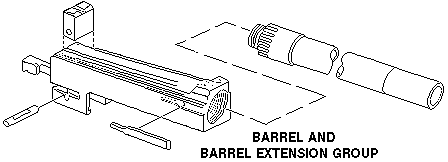 The cover group, located on top of the weapon, is composed of the cover, belt feed slide group, cover extractor cam, cover extractor spring, and belt feed lever. The cover group pulls ammunition into the feedway and enables the extractor to pull rounds from the bolt.
The back plate assembly is mounted in the receiver side plate's groves. The back plate cushions the impact of the bolt and starts the bolt forward.
The cover group, located on top of the weapon, is composed of the cover, belt feed slide group, cover extractor cam, cover extractor spring, and belt feed lever. The cover group pulls ammunition into the feedway and enables the extractor to pull rounds from the bolt.
The back plate assembly is mounted in the receiver side plate's groves. The back plate cushions the impact of the bolt and starts the bolt forward.
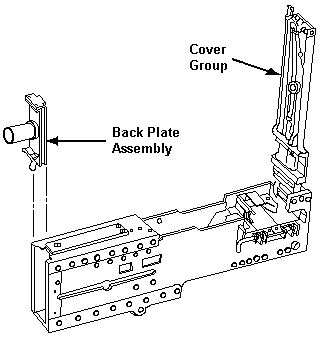 This group is comprised of the receiver and barrel jacket. The purpose of this group is to house the internal working parts of the gun and support the stationary parts.
This group is comprised of the receiver and barrel jacket. The purpose of this group is to house the internal working parts of the gun and support the stationary parts.
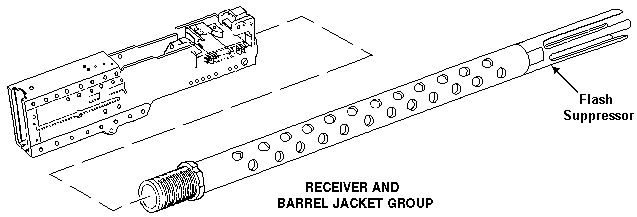
Sources and Resources
http://www.fas.org/man/dod-101/sys/ac/equip/m296.htm
Maintained by Robert Sherman
Originally created by John Pike
Updated Tuesday, January 12, 1999 3:22:36 PM









